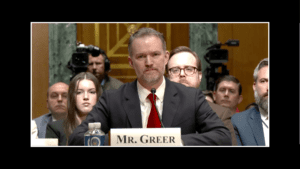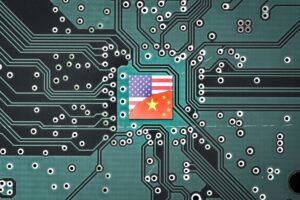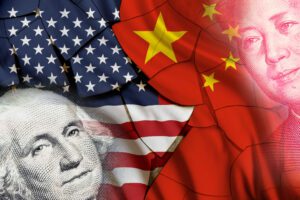Countering China’s Trade & Investment
Agenda – Opportunities for American
Leadership

|
On April 18, 2023, Jamieson Greer testified at a Ways and Means Committee hearing on Countering China’s Trade & Investment Agenda and Opportunities for American Leadership. As President Trump’s nominee to be the next United States Trade Representative, Jamieson Greer will be appearing before the U.S. Senate Finance Committee on Thursday, February 6, 2025 |
|
China’s DeepSeek AI Shakes Up the Game

|
[DeepSeek] unveiled V3 in December and R1 in January. Now at the World Economic Forum (WEF) and all over the world, it is the hottest topic people are talking about. Its app has skyrocketed to the top of the U.S. free app charts just a week after its launch. President Donald Trump called the Chinese company’s rapid rise “a wake-up call” for the U.S. tech industry, as its AI breakthrough sent shockwaves through Wall Street. …Some said DeepSeek-R1’s reasoning performance marks a big win for China, especially because the entire work is open-source, including how the company trained the model. Nevertheless, [DeepSeek’s] extremely low cost and efficiency for training AI models are inviting investigations on how it is possible to spend only US$5.6 million to accomplish what others invested at least 10 times more and still outperform. [DeepSeek] shattered the impression that the impression that the US was way ahead of China, as it relates to AI, in large part because China does not have access to the most advanced NVIDIA GPUs. ScaleAI CEO Alexander Wang told CNBC at the sideline of World Economic Forum (WEF) that [DeepSeek has] at least have 50,000 Nvidia H100 chips (though it has not been confirmed), which also has many people questioning the effectiveness of the export controls. …Of course, necessity is the mother of innovation. Not having access to advanced GPUs also serve as a driver for [DeepSeek] and other Chinese AI companies to innovate on more efficient use of computing power. Due to the US export controls, [DeepSeek] has to come up with a more effective way to train the model. So they combined a series of engineering techniques to improve the model architecture, and finally succeeded in breaking through the technological bottleneck under the export ban. Using fewer computing resources to perform complex logical reasoning tasks not only saves costs but also eliminates the need to use the most advanced chips. |
|
01/27/2025 | Judy Lin | AI Supremacy |
Ten Political Risks for 2025

|
By all measures, China seems like the perfect target for Donald Trump’s tariff hikes. It has the largest trade surplus in goods of all U.S. trading partners, it employs a series of unfair trade practices to gain a competitive advantage, and it has failed to live up to the terms of the trade agreement that it signed with President Trump in his first term. Still, Mr. Trump hasn’t imposed new tariffs on China. The 10 percent tariff hike he threatened to impose for its lax fentanyl policies is significantly less than what he promised on the campaign trail. Moreover, it is substantially lower than the 25 percent tariff he may soon put in place against Canada and Mexico. To be clear, this does not mean that tariffs on Chinese products are off the table. Instead, it means that he may be playing for the biggest possible win, albeit with a significant risk of failure. China is a formidable negotiating partner, so success is far from guaranteed. In the meantime, he seems to be directing his retribution toward America’s neighbors, with whom he has more leverage, making an early victory on trade more feasible. Curbing immigration is a key priority for Mr. Trump, so linking tariff threats to efforts to seal the border is not surprising. However, more factors are at play. Both Canada and Mexico, separately, have over three-quarters of their exports destined for the United States, so they are highly dependent on the U.S. market. This dependence provides the United States considerable leverage, and may give Mr. Trump his quick tariff win. China, on the other hand, presents more challenges. During Mr. Trump’s first term, Beijing demonstrated its resolve against U.S. tariffs every step of the way. It shrewdly focused its retaliatory duties on politically sensitive sectors, such as agriculture. Since then, it has developed an even bigger retaliatory toolbox, including holding back exports of critical minerals that the United States depends on. |
|
01/31/2025 | Wendy Cutler | The New York Times |
Unfinished Business: Bringing China Into the
Club of Market-Oriented Countries

|
In recent years, the debate over the United States’ economic relationship with China has reached ever higher levels of hand-wringing and agonizing. While there is a view that mistakes were made in the past, there is little agreement on what those mistakes were or what actions should be taken now, aside from a vague sentiment that the United States’ response to China’s trade practices should be tougher. Part of the problem in looking for a way forward is that it is not clear where exactly people — U.S. government officials, policy wonks, ordinary voters — want to go. Is the goal to make China more like the U.S. in terms of the role of the market in its economy and economic policymaking? Is it to “fix” the bilateral trade deficit by encouraging China to buy more from the U.S. and sell less to the U.S.? Or is it to exclude Chinese companies from U.S. markets so that American companies do not have to compete with them? Which of these goals the U.S. ultimately adopts will determine the approach it takes regarding the rules surrounding trade with China. If the choice is to keep China out of the U.S. market, the answer is simple: Unilateral tariffs and other restrictions will do the job — at a serious cost to the economy, of course. And if the focus is on reducing the trade deficit, a greater willingness to address the macroeconomic causes of trade deficits, such as low U.S. savings rates, is needed. But if the United States wants China to be more market-oriented, in the sense of moving towards an economy driven by the forces of supply and demand — and that’s what it should want, because this will make both China and the U.S. better off — then there needs to be a discussion of strategy. How exactly can the U.S. nudge China in that direction? As a general matter, influencing the domestic policies of other countries is a delicate operation. But the foundation has already been laid at the World Trade Organization (WTO), and progress could be achieved here if 1) this objective were made a priority of U.S. policy, and 2) policymakers thought carefully about what might be most effective. |
|
01/15/2025 | Simon Lester | Baker Institute |
WITA – We put the community in trade community.Information about upcoming WITA and trade community events TRADE COMMUNITY EVENTS CALENDAR |


